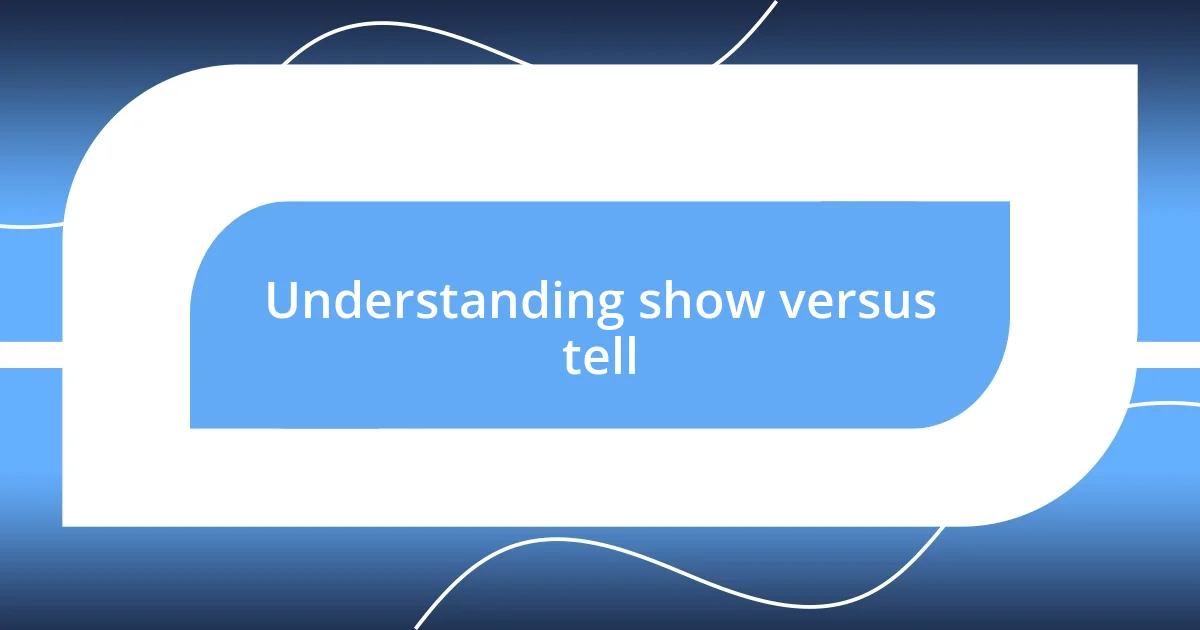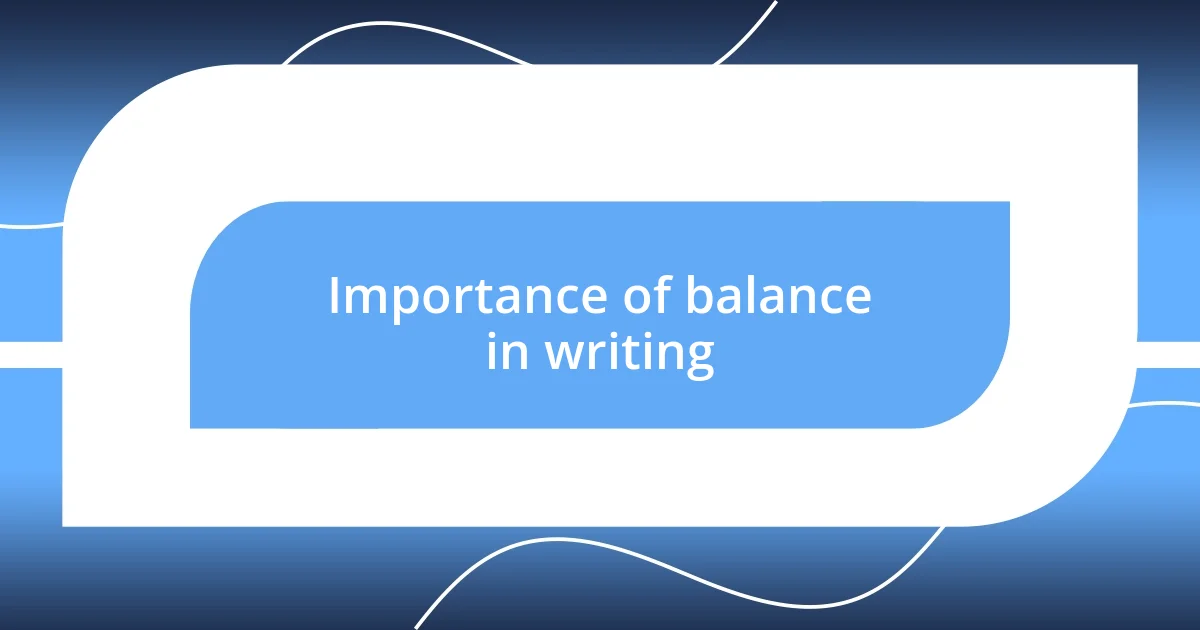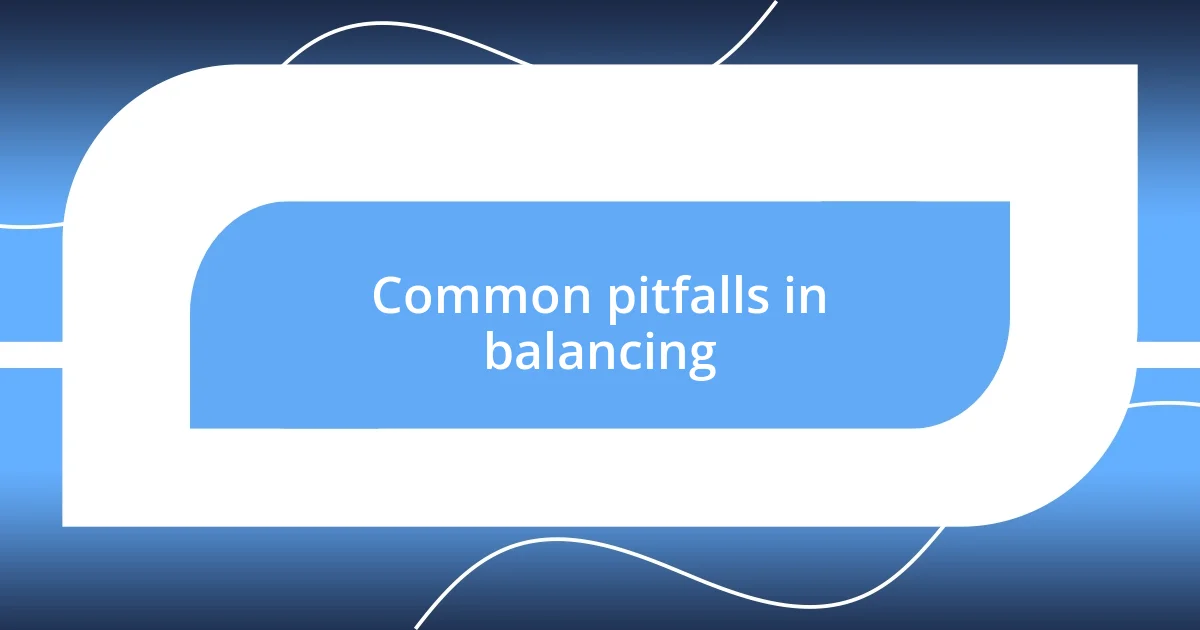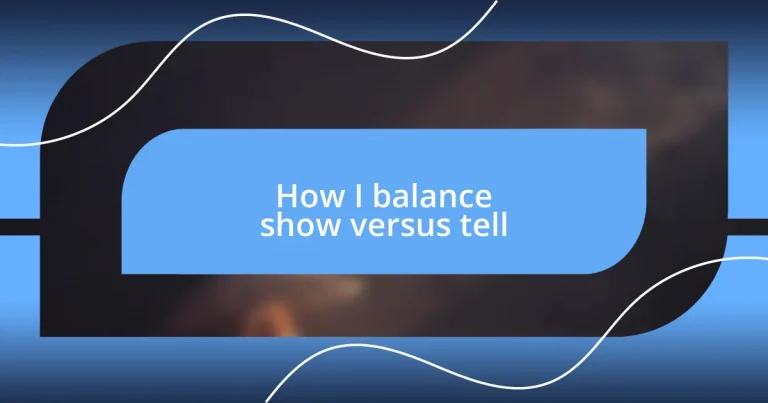Key takeaways:
- Effective storytelling requires a balance between showing and telling, as each serves unique purposes—showing immerses readers, while telling clarifies and speeds up the narrative.
- Common pitfalls include overusing showing, leading to reader fatigue, and neglecting telling, resulting in emotional disconnect and confusion.
- Practical exercises, like the “Show vs. Tell Challenge” and analyzing published works, can improve writing by enhancing the use of sensory details and emotional engagement.

Understanding show versus tell
Understanding show versus tell starts with recognizing that each approach serves a unique purpose in storytelling. I remember an early writing workshop where an instructor pointed out that showing allows readers to feel immersed in the scene, while telling simply informs them. Have you ever found yourself drifting from a story that felt too much like a summary? That’s the magic of showing—when done right, it pulls you right into the characters’ emotions and experiences.
When I reflect on my own writing journey, I realize how tempting it can be to tell the audience everything rather than allowing them to experience the emotions firsthand. For instance, instead of saying, “She was angry,” I’ve learned to depict her actions—clenching fists, a fire in her eyes—as a way to convey that emotion. It makes the scene more vivid and relatable. Don’t you think that when we experience emotions through a character’s actions, they resonate more deeply?
Interestingly, the balance between showing and telling is a delicate dance. Sometimes, a brief moment of telling can clarify a complex situation, like when I’ve described a character’s background succinctly to set the scene. But to truly connect with readers, it’s essential to give them the sights, sounds, and feelings that paint the world around them. Have you ever noticed how your favorite books manage this balance? It’s often what makes the story stick with us long after we’ve turned the last page.

Importance of balance in writing
Finding the right balance between show and tell in writing is crucial for creating a compelling narrative. I’ve often found that excessive telling can lead to disengagement. When I was working on a short story, I noticed that my readers were skimming through sections where I summarized emotions instead of painting a scene. That feedback reminded me that the heart of a story lies in the moments I let my readers truly experience.
Here are a few reasons why balancing show and tell is essential:
- Engagement: Showing invites readers into the narrative, making them feel like active participants rather than passive observers.
- Emotional Connection: Through showing, readers can empathize with characters, allowing for deeper emotional resonance.
- Pacing: Telling can speed up the narrative in places, which is vital for maintaining momentum without sacrificing depth.
- Clarity: Sometimes, a quick tell alongside detailed show can eliminate confusion, ensuring readers grasp essential plot points.
I’ve learned that mastering this balance ensures each moment in my writing is purposeful, drawing readers in while keeping their interest alive.

Common pitfalls in balancing
Missteps can easily occur in the delicate act of balancing show versus tell. One common pitfall arises when a writer relies too heavily on showing, overloading readers with minute details. I once faced this in a chapter where I described a character’s mundane afternoon in painstaking detail. Readers quickly grew tired and mentioned feeling lost in the minutiae. It became clear that sometimes, a concise telling could streamline the narrative without losing its charm.
Another issue is underutilizing telling, which can leave readers with gaps in understanding. I distinctly remember writing a scene where a character faced a serious dilemma but didn’t explain why it mattered emotionally. My beta readers mentioned they felt disconnected, as they couldn’t grasp the stakes. This experience taught me that blending thoughtful telling—like a character’s internal dialogue—with rich, immersive showing invites readers to invest in the story.
Ultimately, it’s about finding what works for each moment in your narrative and adapting accordingly. When I combine the evocative descriptions with efficient summaries, it keeps the plot moving while still resonating with emotion. Think of it as a dance; sometimes you take center stage, while other times, it’s best to let the audience absorb what’s happening.
| Common Pitfalls | Consequences |
|---|---|
| Over-relying on showing | Reader fatigue and confusion |
| Neglecting telling | Gaps in understanding and emotional disconnect |
| Poor pacing due to imbalance | Loss of narrative momentum |

Practical exercises for improvement
One great exercise I’ve found helpful is the “Show vs. Tell Challenge.” I pick a simple sentence, like “He was sad,” and then write a paragraph showing that emotion through action, dialogue, or sensory detail. Recently, when I tackled this, I focused on a character who had just lost something important. Instead of stating his sadness, I described how he stared blankly at the ground, his hands trembling as he fiddled with a frayed necklace. This not only deepened the emotional impact but also allowed me to explore the character’s thoughts and surroundings.
Another effective method is to analyze passages from published works. I enjoy selecting a few paragraphs where the author either shows or tells, noting how the choice affects the narrative tone and pacing. I remember dissecting a passage from a novel where the protagonist’s joy was depicted through vivid imagery—dancing leaves, the warmth of sunlight on skin—instead of a simple declaration. It felt like a revelation, prompting me to ask, “How can I incorporate similar techniques in my own writing?” This reflection pushed me to enhance my scenes with sensory details, making them more engaging for the reader.
Lastly, free writing without thinking about the balance between show and tell can be incredibly liberating. I set a timer for ten minutes, letting my thoughts flow freely onto the page. Surprisingly, I often discover moments where I’ve leaned too much one way or the other. During one of these sessions, I ended up writing a scene about a rainy day that started with all the telling but blossomed into a vivid experience as I described the smell of wet earth and the sound of raindrops tapping against the window. It helped me to intuitively gauge the balance in my writing without overthinking it. Have you tried any of these exercises? They might just unlock new dimensions in your storytelling!














